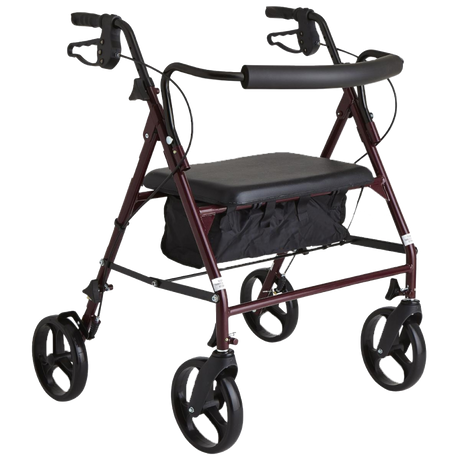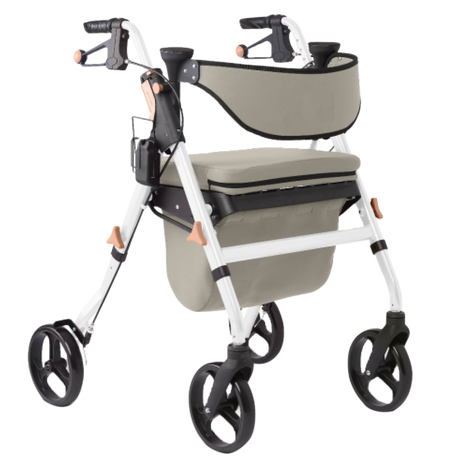Embracing the journey of aging gracefully often comes with its unique set of challenges. For those who wish to maintain their independence, a rollator walker can be an invaluable tool. However, learning how to use a rollator walker properly takes some practice.
From navigating diverse terrains to maintaining the proper posture, there’s a lot to learn. In this blog post, we’ll walk you through each step, empowering you to use your rollator confidently and safely, maintaining your sense of self-assurance and independence.

How to Use a Rollator Walker
Learning how to use a rollator walker properly is the key to unlocking newfound freedom in your daily routine. Let’s delve into the essential steps that will guide you through the process.
Before You Go - Adjusting Your Rollator Walker
Start by choosing a height-adjustable, 4-wheel rolling walker with a sturdy frame. Before you even take that first step, spend a few moments ensuring that your rollator is adjusted to your personal specifications. Proper height and brake adjustment is key for safety and comfort.
The handles should align with your wrists when your arms are comfortably at your sides. This not only prevents unnecessary strain but also promotes a more natural and balanced gait. Remember, a rollator is a mobility aid used to provide balance and support, so don’t hesitate to make adjustments until it feels just right.
Correctly Gripping the Handles
A secure and comfortable grip on your rollator handles is foundational to a confident walk. Aim for a relaxed grip that neither strains your hands nor compromises your control. Keep your wrists in a neutral position and avoid excessive bending.
By maintaining this ergonomic grip, you not only reduce the risk of discomfort, but your rollator essentially becomes an extension of your movement.
Walking with the Rollator Walker
With your rollator properly adjusted and your grip secure, it’s time to start walking. Start with small steps, maintaining a natural stride. Keep your head up and look straight ahead, not down at your feet.
This not only improves your posture but also enhances your awareness of your surroundings. Gradually increase your pace as you become more comfortable, but don’t compromise your balance by exceeding your comfort level.
Push the rollator forward and step toward it, ensuring that your feet are just inside the back wheels. Don’t walk too far inside the rollator or overstretch by placing the rollator too far in front.

Using the Brakes While Walking
Safety is paramount when using a rollator, and that means knowing how to apply your brakes properly. Familiarize yourself with the brakes and their operation before you take your first steps. You may need to tighten your brakes before you get started to ensure stability. Be sure you know how to lock the brakes and adjust their tension according to your preference.
To use the brakes while walking, gently squeeze the brake handles when you need to slow down or come to a stop. Practice using the brakes on a level surface until it becomes second nature. This will ensure that you have the confidence to navigate various terrains while maintaining control of your rollator.
Proper Posture
Proper posture is the backbone of a comfortable and stable rollator walk. Stand upright with your shoulders relaxed and avoid slouching. Engage your core muscles for added stability. This not only enhances your overall comfort but also maximizes the balance-enhancing benefits of your rollator walker.

How to Sit Down Safely
When it’s time to take a break, knowing how to sit down safely ensures a seamless transition. Position your rollator so that it is stable, engage the brakes, and turn your body facing away from the seat. With a secure grip on the handles, lower yourself gently onto the seat.
How to Stand Up Safely
Standing up from a seated position with your rollator is a deliberate process. Begin by placing your feet firmly on the ground, shift forward in the seat, and use the rollator handles for support as you rise. Turn your body to face the rollator, assume the correct posture, and resume your walk.
Going Up and Down a Curb with a Rolling Walker
Navigating curbs with your rollator requires a bit of technique to ensure a smooth and safe transition. Follow these steps to confidently handle curbs and maintain your stride:
Approaching the Curb
If possible, choose a curb with a ramp for easier navigation. If no ramp is available, look for a slightly angled or lower section of the curb to approach. As you approach the curb, ensure you’re at a perpendicular angle to the curb for optimal stability.
Going Up
When ascending the curb, position your rollator close to the curb’s edge, ensuring that both front wheels are aligned. To maintain stability, place one hand on the rollator handle and the other on a stable surface, such as a railing, wall, or someone’s shoulder.
Engage the brakes. With a controlled motion, tilt the frame back to lift the front wheels onto the curb, followed by the rear wheels. Once your rollator is safely on the curb, use it for balance as you step up. Release the brakes and continue walking.
Going Down
Descending a curb requires a controlled and deliberate approach. Position your rollator with its front wheels at the edge of the curb. Engage the brakes, and if possible, use a stable surface for support.
Lower the front wheels first, ensuring they land squarely on the lower surface. Follow by gently lowering the rear wheels. Once your rollator is safely on the lower level, use it to maintain your balance as you step down, release the brakes, and resume your walk.

How to Use a Rolling Walker Properly on Uneven Terrain
When faced with uneven surfaces or grassy areas, take a moment to assess the terrain. Look for smoother paths or areas with shorter grass to make your journey more manageable. If possible, choose a route that minimizes bumps and obstacles.
Ensure that your rollator’s wheels are aligned and take short steps, lifting your rollator just slightly if needed to help it roll over the grass or bumps. Keep a firm grip on the handles, and if needed, engage the brakes to control your pace. Take your time, allowing the rollator to move steadily over irregularities.
Tips for Using a Rolling Walker
Be Patient and Take Time to Adjust
Adjusting to a new mobility aid takes time, and your rollator is no exception. Be patient with yourself as you learn the ins and outs of its operation. Fine-tuning the height, grip, and brake adjustment might require a few attempts. Make the adjustments gradually until you find the settings that offer the most comfort and support.
Take Breaks When Needed
Walking with a rollator can be strenuous, especially if you’re not accustomed to regular exercise. Listen to your body and take breaks when necessary. Whether you’re strolling through the neighborhood or exploring a local park, pauses allow you to rest and appreciate your surroundings, preserving your energy for the rest of your adventure.
Keep Your Eyes Out As You Walk
Maintain awareness of your surroundings as you navigate with your rollator. Keep your gaze forward, allowing you to anticipate any potential obstacles or changes in the terrain. Staging vigilant enhances your safety and enables you to make real-time adjustments to ensure a smooth and secure walk.
Transporting a Rollator Walker
Being able to take your rollator on the go is important. Our rollator walkers are designed to fold easily for convenient transportation and storage. Familiarize yourself with the folding mechanism on your specific model, and ensure that your rollator is securely folded before attempting to lift it.
When lifting your rollator, maintain a stable stance by bending at your knees rather than your waist. Grasp the rollator handles with one hand and the frame with the other. Take your time and lift with controlled movements to prevent strain, and don’t hesitate to ask for help if you need it. Once your rollator is in the vehicle, secure it in place to prevent shifting during transit.
Ready to Start Your Rollator Journey?
Having the extra support of a rollator provides the freedom to walk with confidence. Ready to experience the benefits of a rollator for yourself? Shop the selection of height-adjustable, 4-wheel rolling walkers at Because Market to reap the rewards of independence and daily exercise!
Sources:
Elderly Fall Prevention. (2023, Apr. 10). Discover the Benefits of Rollator Walkers. https://elderlyfallprevention.com/discover-the-benefits-of-rollator-walkers/
Eggermont LH, van Heuvelen MJ, van Keeken BL, Hollander AP, Scherder EJ. Walking with a rollator and the level of physical intensity in adults 75 years of age or older. Arch Phys Med Rehabil. 2006 May;87(5):733-6. doi: 10.1016/j.apmr.2006.02.008. PMID: 16635639.









